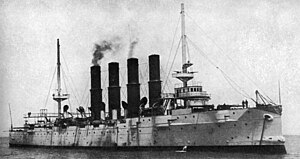 Varyag c. 1904
| |
| History | |
|---|---|
| Name | Varyag |
| Builder | William Cramp & Sons, Philadelphia |
| Yard number | 301 |
| Laid down | October 1898 |
| Launched | 31 October 1899 |
| Commissioned | 2 January 1901 O.S.: (14 January 1901 N.S.) |
| Fate | Scuttled, 9 February 1904 |
| Name | Soya |
| Acquired | by Japan as prize of war |
| Commissioned | 9 July 1907 |
| Fate | Returned to Russia, 5 April 1916 |
| Name | Varyag |
| Acquired | 5 April 1916 |
| Out of service | seized by Great Britain February 1918 |
| Fate | Ran aground 1920, scrapped 1925 Firth of Clyde |
| General characteristics | |
| Type | Protected cruiser |
| Displacement | 6,500 long tons (6,604 t) |
| Length | 129.6 m (425 ft 2 in) w/l |
| Beam | 15.8 m (51 ft 10 in) |
| Draught | 6.3 m (20 ft 8 in) |
| Installed power |
|
| Propulsion | 2 shafts; triple-expansion steam engines |
| Speed | 23 knots (43 km/h; 26 mph) |
| Complement | 570 |
| Armament |
|
Varyag (Russian: Варя́г) sometimes also spelled Variag, was a Russian protected cruiser. Varyag became famous for her crew's stoicism at the Battle of Chemulpo Bay. She was acquired as a prize of war during the Russo-Japanese War by the Imperial Japanese Navy, who renamed her Soya and was later returned to the Russian Imperial Navy during World War I.